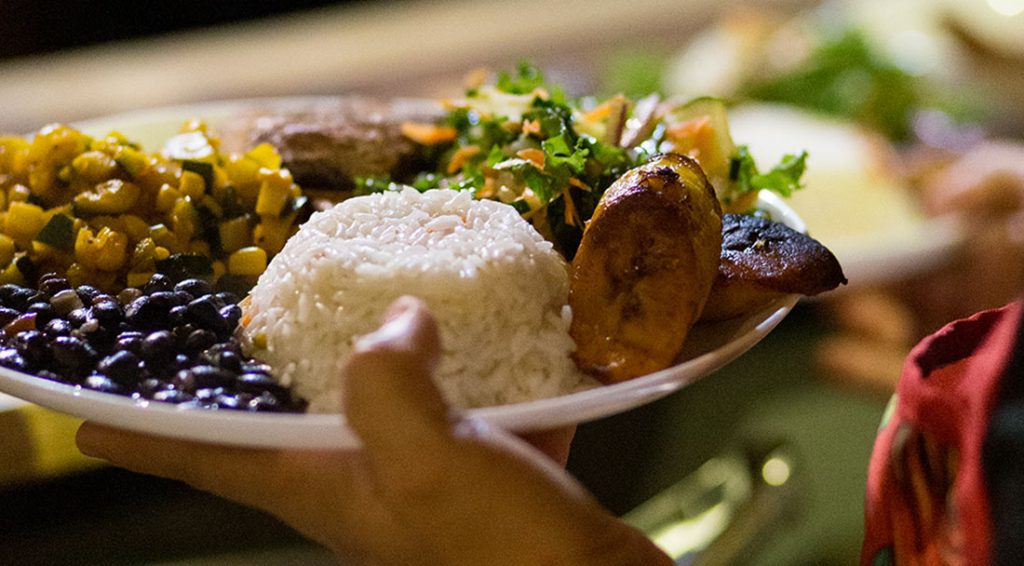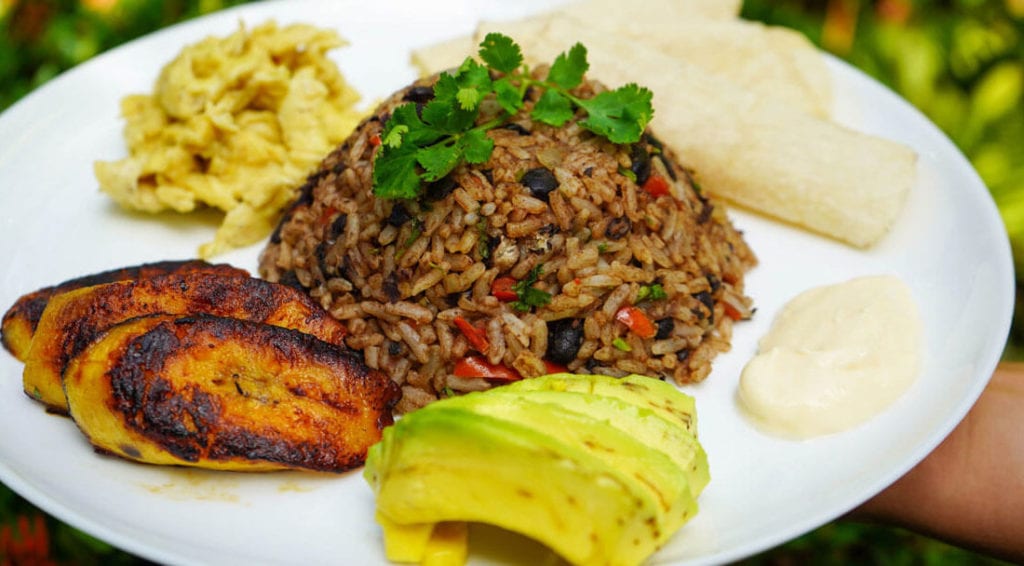A typical surf session with Bodhi Surf + Yoga ends with a fresh coconut to drink and eat. Early in the morning, local seller Andrés harvests the coconuts off the trees and cuts them for beach goers right at the entrance of Playa Chamán here in Uvita, Costa Rica.
There’s nothing like having a fresh coconut after a surf session full of sun and fun. Have you ever wondered where coconuts come from? What actually are they? (Spoiler alert: they’re not in the nut family) And how are they used?
Today we are going to answer your coconut questions… And maybe some questions you never even asked. Let’s get crackin,’ shall we?
First, let’s get some of the science information out of the way. The cocos nucifera is part of the palm tree family. It’s important to understand that not all palm trees grow fruit or coconuts.
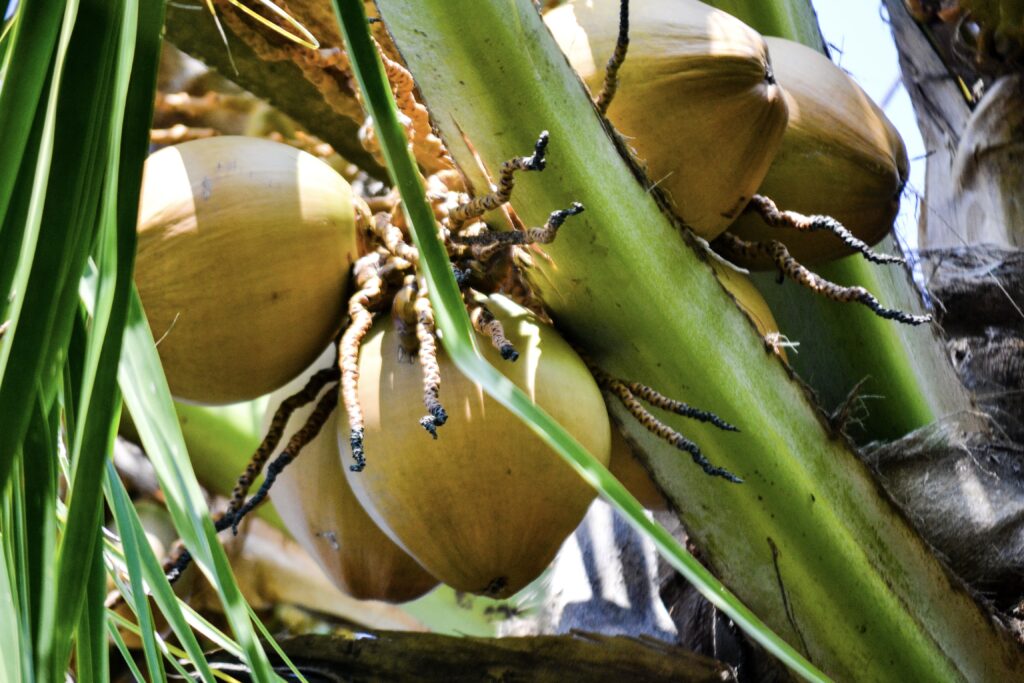
But what actually is a coconut?
The coconut is botanically categorized as a drupe or stone fruit. These types of fruit have a soft, fleshy outside with a solid, woody pit or core. Some popular stone fruits you may have eaten are peaches, mangos, cherries, plums, cherries, and olives. Shockingly, an avocado is not considered a drupe.
Unlike its fruity cousins, the coconut has a hard shell for the exocarp (its skin). This is most likely why “nut” is in its name. The mesocarp (its flesh) is a dry, fibrous husk which isn’t really edible or sweet. The endocarp (its pit) is another hard shell protecting the endosperm, embryo, and holding its sweet water. A fully ripe coconut is a complete seed.
Once separated from its tree, a mature coconut may start to sprout after three months. The tiny embryo inside will slowly grow as it consumes the water and meat. The sprout will grow through the weakest point of the shell, the “eyes.”
These small dark circles are called germ pores. One of the eyes is typically softer than the others, this is where the sprout can grow out, or your straw can go in.
When a coconut has sprouted, the inside is still edible. The water and meat turns into a spongey ball in the center that contains more enzymes and nutrients. Depending on the coconut, its sprouted taste could be sweet, savory, or “bleh” and bland.
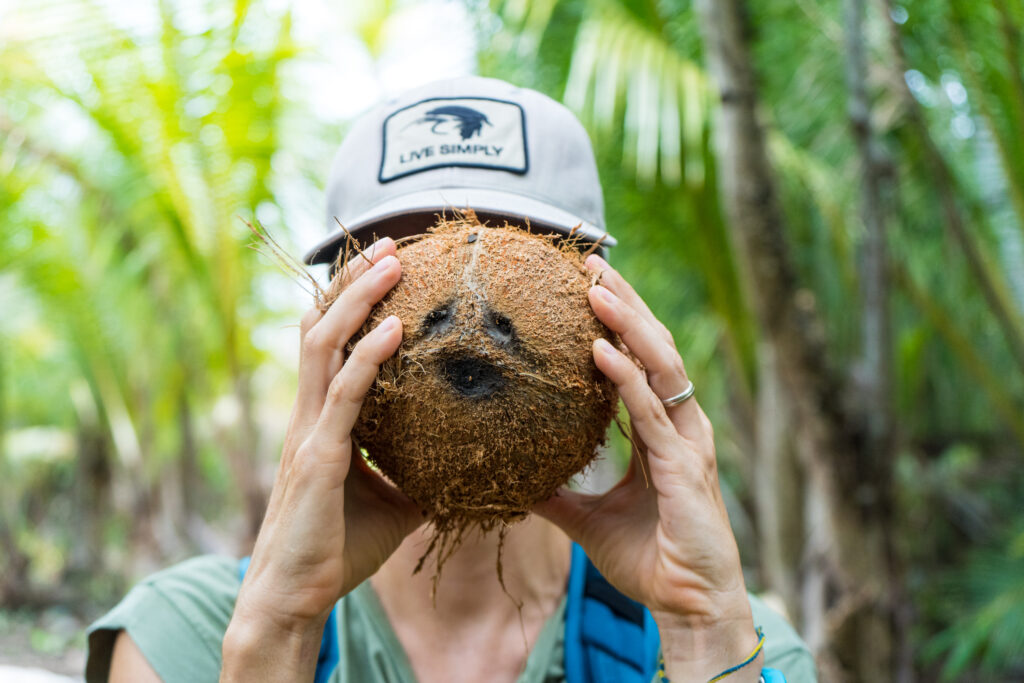
Some quick facts about the coconut tree:
- They can grow 50 to 100 feet and 2 feet per year on average
- Requires 6 to 10 years to grow fruit and can produce 30 fruit per year
- Prefers soil that holds a lot of water such as sandy beaches
- The leaves can grow 13 to 20 feet long
- The root system grows horizontal with 20+ feet in size and 1 to 3 feet deep
- Botanically is not considered a tree but a perennial monocotyledon
Where did the coconut first come from?
It is believed that the coconut originated from Africa, but to many scientists it is still a mystery. A group of people called the Austronesian have a big influence spreading the coconut around the world. They are a large group of prehistoric people who have migrated spanning from southeast Asia to Madagascar to Papua New Guinea to New Zealand circa 3000 to 1500 BCE.
Along with other crops and animals, the Austronesian people brought the coconut with them to domesticate on many indo-pacific islands. They figured out how to make vinegar with coconut water, which in turn preserved their meat longer. This may be the origin of the dish Ceviche.
By having preserved meat, they could travel farther distances. They brought the coconut literally around the southern hemisphere of the world.
But going back to ceviche – Costa Rica is famous for this. Kinsu, a local restaurant minutes away from Bodhi Surf + Yoga serves Costa Rican style dishes with the freshest ingredients, with one of our absolute favorites being their ceviche. They have a unique spin on ceviche, using coconut milk from Davíd – a local coconut farmer. We’ll talk about him later.
We don’t shy away from using coconut milk in our meals here at Bodhi Surf + Yoga. In fact, many of our signature dishes use coconut ingredients – check out our fam-favorite recipes in our online cookbook!
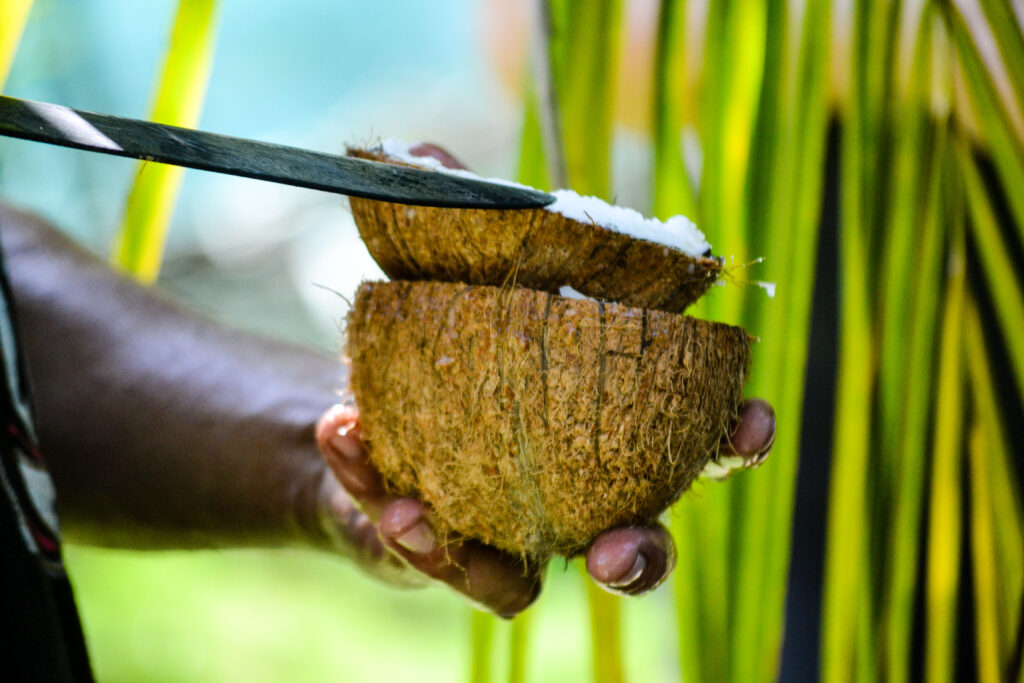
But there is still a big mystery…
There is evidence of coconuts growing on uninhabited islands, thousands of miles away from any other land mass. The coconut has adapted to float on water, even in the ocean. A study has proven that they can float for up to seven weeks. Experts believe that coconuts simply floated their way from island to island, just like the Austronesian people.
There are two main types of coconuts called Niu Vai and Niu Kafa. These are Samoan names that distinct the two varieties. Niu Kafa is characterized by having an obtuse triangle shape, a thick husk, and having more meat than water. Niu Vai is more rounded with a thinner husk and has more sweet water when it’s unripe.
Just so you know…
A green Niu Vai or Niu Kafa is not fully ripe. It is often mistaken that a green coconut is a different variety. The husk will continue to grow in size and turn brown. A fully ripe coconut will have more meat and less water inside.
Heads up!
When you’re about to set up at a tropical beach like Playa Chaman in Uvita, be sure to look up at the trees. Coconuts can weigh between two and five pounds. They can cause severe injury to the head and spine when falling from a tree.
What else are coconuts used for?
Great question! Here’s another list:
- Oil, flour, and sugar (cookies, anyone?)
- Sports drinks: the water is full of electrolytes
- Skin and hair care products
- Toothpaste from the oil
- Bug repellant base
- Rope from the husks
- Bowls from the inner shell
- Activated charcoal
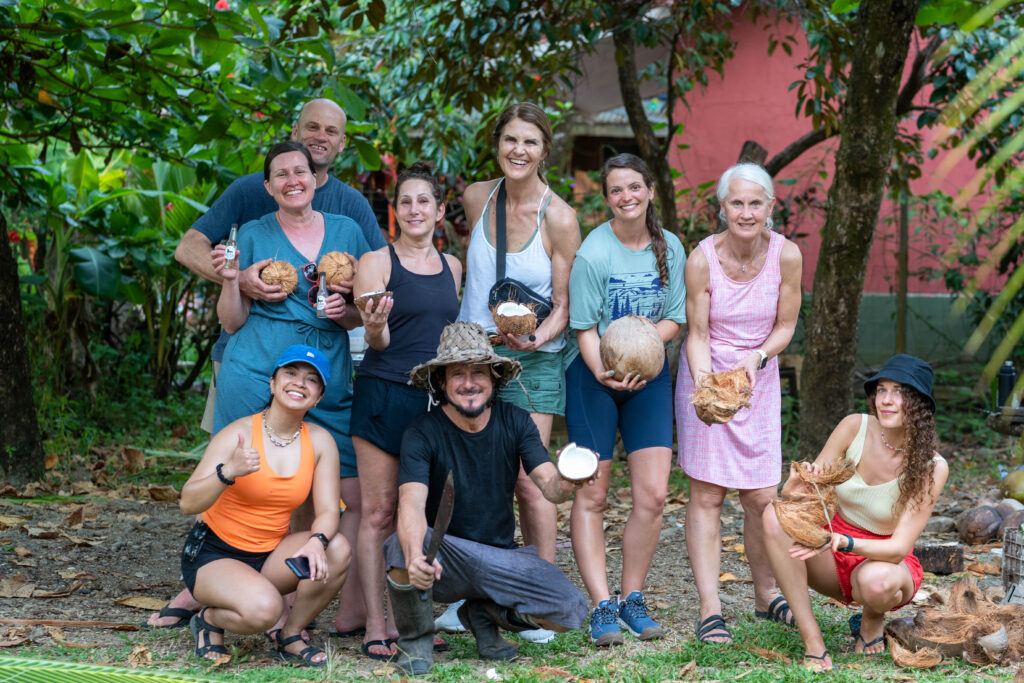
The Coconut Tour
Hopefully you’ve realized that coconuts are so versatile, eco-friendly, and delicious. Someone who has unlimited passion for coconut is Davíd. He is the local coconut farmer right outside of the Marino Ballena National Park in Uvita.
Davíd continues traditional methods of coconut farming, harvesting, and extracting. On his tour he will teach and show you everything about coconuts in the most traditional way possible.
At Bodhi Surf and Yoga, we don’t tell our guests too much about what the tour entails, and we will do the same here. The tour takes you through the coconut opening all the way to separating the milk and oil. Head over to our instagram for a little sneak-peak of what else this unique experience includes. While you’re there toss us a follow – don’t be shy!
He will also explain the bazillion uses of every part of the coconut tree: from the leaves to the coconuts that are sprouting. All of this while receiving a fun, hands-on experience with tasty snacks in between.
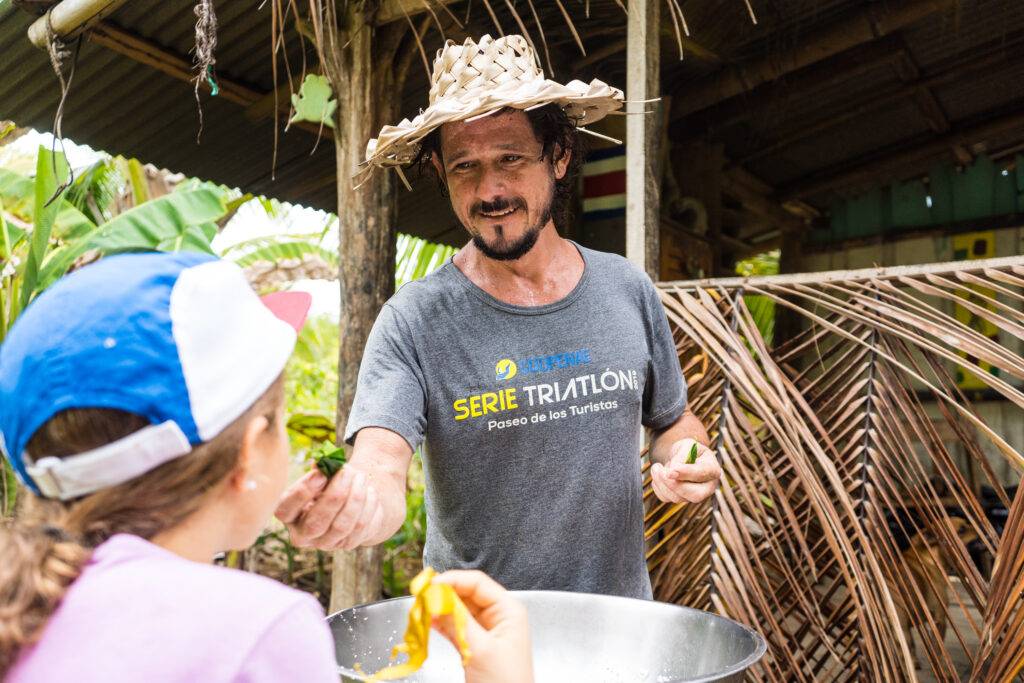
The big Bodhi picture
Davíd is one of many locals who protect, preserve, and educate visitors of this precious place in Uvita, Costa Rica. He works with Marino Ballena National Park to restore and preserve the land by planting coconut trees.
Bodhi Surf and Yoga has a mission to expose our guests to the local community, nature, and sustainability practices. Our commitment is to lead by example for future generations of environmentally conscious tourism and business practices.
So, when Andrés cuts open a green coconut for you after your surf session, take a moment to think about where and how this tasty wonder-fruit came to be. Think about how much energy and time it took to create, and how much replenishment and joy it brings to you.
Get the Best Bodhi Lodge Recipes in Your Inbox
Get step-by-step Guest and Staff favorite recipes from our kitchen at the Bodhi Lodge. Your stomach will thank you!
Change the heading on the Separator tab ->
Search
Get the Best Bodhi Lodge Recipes in Your Inbox
Get step-by-step Guest and Staff favorite recipes from our kitchen at the Bodhi Lodge. Your stomach will thank you!
Change the heading on the Separator tab ->
Most Read Blogs
What is the Meaning of Anjali Mudra?
May 27, 2020
Fitness for Surfers: Workouts, Exercises & Training
February 10, 2022
The Best Places to Eat in Uvita, Costa Rica
May 19, 2022
How to Get From SJO to Costa Ballena, Costa Rica
May 31, 2018
Change the heading on the Separator tab ->
Categories
Categories
- Bodysurfing (5)
- Food (7)
- Responsible Business (6)
- Surfing (64)
- Travel (65)
- Yoga (41)
Change the heading on the Separator tab ->
Newsletter
Thanks for subscribing! Please check your email for further instructions.
Change the heading on the Separator tab ->
Follow Us
Guest Post
Change the heading on the Separator tab ->
Read more
Must Try Food in Costa Rica – Costa Rican Cuisine
Words by George Frost
Home to luscious rainforests, pristine beaches, diverse wildlife, and incredible national parks, Costa Rica is one of the best places to be all year round. But there’s more to the gorgeous Central…
The Best Places to Eat in Uvita, Costa Rica
Words by George Frost
More often than not when our guests book with us here at Bodhi Surf + Yoga, they email us asking about our home, Bahia Ballena – Uvita. What’s the most common thing…
Gallo Pinto: Recipe & History of Costa Rica’s Traditional Beans & Rice Breakfast
Words by Bodhi Surf + Yoga
Gallo Pinto is a simple and classic breakfast consisting of rice, beans, and Salsa Lizano (another Tico must-try). What Is Gallo Pinto? Gallo Pinto, the national dish of Costa Rica,proves that simple…


